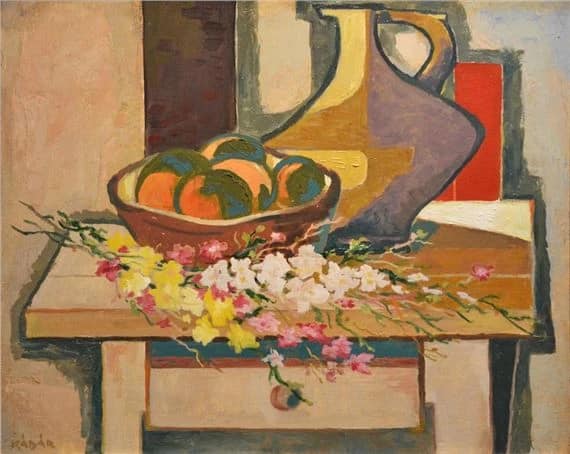Yes, there is still life in the Still Life series… As we said in the last still life blog, it was once considered the lowest art form; this is complete nonsense when we see the variety & accomplishment on a list such as today’s. Whether the subjects are abstracted or the artist has gone for super reality, they all have something about them. I’ve gone for variety as well as quality here. They tell us more about the artist too: buttoned-up, free & easy or incredibly controlling…? Of course the artists might be using their works to obfuscate; nevertheless, with such actions they are revealed…
Louis le Brocquy (1916-2012), Study of Fruit
Ask me which of these entries I would keep if I had the chance & this would be in my top two. I love all the le Brocquy paintings I’ve had the chance to see - they’re even more remarkable in person. Abstracted enough to make the viewer take another close look, they’re still recognisably fruits & I do love the way he blurs the edges to focus the eye on the central pieces.
Vilhelm Hammershøi (1864–1916), Still life with geometric forms, 1879
Hammershøi’s painting of his sister featured last week & I don’t think it’s possible to get enough of his work. Whilst there might seemingly be a danger of his work being samey due to the relentlessly limited palette of his paintings, their stillness & their quietude, yet they contain mystery & the viewer is invited into his interiors to create their own narratives. Even in this still life he has piled up some shapes wherein the dominant object is the cross. What I like most about Hammershøi? He makes you wonder.
Pedro Campos (b. 1966), Hot Day III
Does photo reality get more impressive than this? Sometimes you can see a tiny bit of the artist’s hand, some brushwork or a minute dot of impasto. Not so with Campos’s painting. & yes, they’re all this extraordinary. Truly astonishing.
William Orpen (1878–1931), Still life of a porcelain statuette, a fan and a powder puff
Despite his popularity as a portraitist, Orpen’s still life images are also beautiful. He’s one of these great artists - & war artists - that made it during his lifetime & it makes you grateful. His draughtsmanship was staggering & his self-portraits in particular show wit & an endearing self-deprecating side.
Hans Memling (1430-1494), St. John & Veronica Diptych (reverse of the right wing), 1483
I’ll admit, snakes scare me, but I’m willing to ignore this slightly daft tiddler since it’s sort of like a comedy toy with its tiny tongue hanging out. It’s the only part of the painting that isn’t entirely believable. The light & the metallic surface of the chalice are sensitively & realistically rendered. Having said all that, the other half of the diptych shows what is also – frankly - a comical skull.
György Kádár (1912-2002), Still Life with Branch
Several of this Hungarian artist’s works have appeal – some are prints & some, such as this piece, experiment with Cubism. He was also known to work in mosaic, stained glass, murals & book illustration. Other subjects included landscapes & I think he was perhaps an art teacher for a time…? If anyone can find any other biographical information on György Kádár, I’d love to read it.
José Daniel Ramirez Amador? 2020?
What I like about this work is despite the “super-reality,” you can see the “joins.” The brushwork is present, the hand of the artist is present. The only problem is when I found the image, this was the name that came up – now I can’t find it to verify this. If I find out more, I’ll include it!
Jan Lievens? (1607–1674), Vanitas-Stillleben, 1628-1630?
What I like about this accomplished ramshackle of a work is that it’s like a mini history of book-making (as in the making of a reading book…) Sheets of paper bundled & fixed together, sheets of paper bound with a leather strip, hardbacks, paperbacks, landscape layout, portrait layout, printed, illustrated, handwritten. All that before you even get to the statue on the shelf of the headless woman that appears to have fallen over.
Roy Lichtenstein (1923-1997), Still Life, 1974
I sort of prefer this to Lichtenstein’s action works. This seems somehow subversive, deleting & redefining centuries of art history into a totally serviceable work. The objects are unmistakeable & the composition works well in terms of placement & colour. I’ll never love his images unconditionally, but this comes close.
Lachlan Goudie (b. 1976), Stolen Moment, 2020?
This is my other top two of the week in case you were wondering. Contemporary Scottish Colourist still life. Bliss.










Comments
Post a Comment